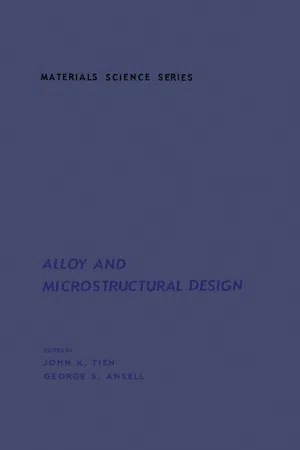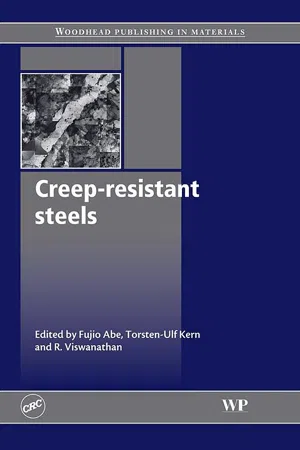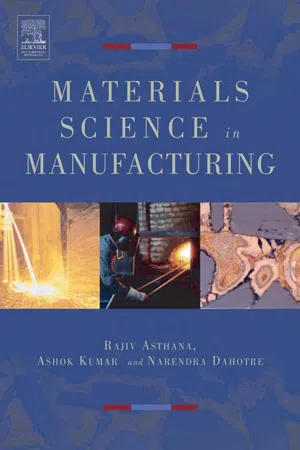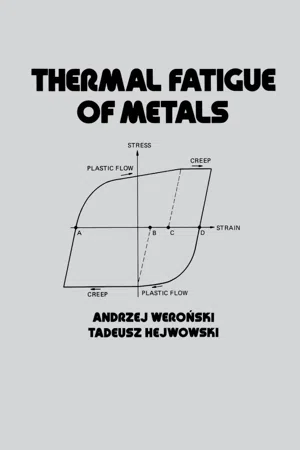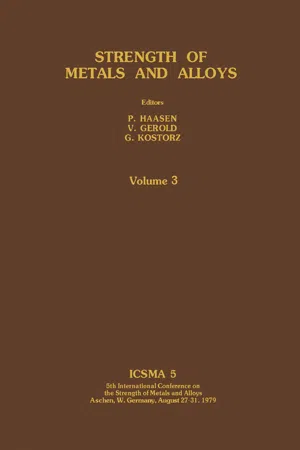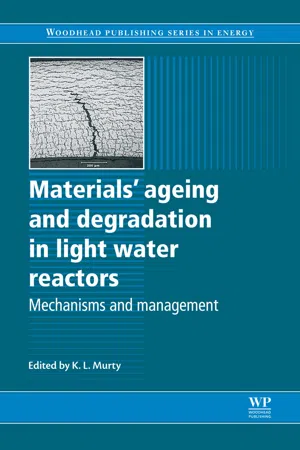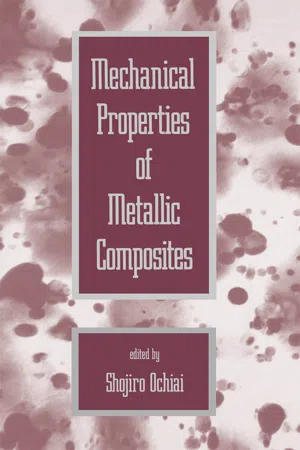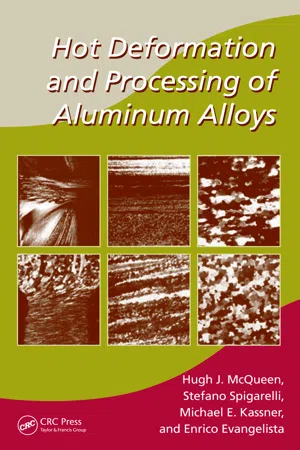Technology & Engineering
Diffusion Creep
Diffusion creep is a type of creep deformation in materials that occurs at high temperatures and low stresses. It is driven by the movement of atoms through the crystal lattice, leading to the gradual flow and deformation of the material. This process is important in understanding the behavior of materials in high-temperature environments, such as in the aerospace and power generation industries.
Written by Perlego with AI-assistance
Related key terms
1 of 5
9 Key excerpts on "Diffusion Creep"
- eBook - PDF
- John Tien(Author)
- 2012(Publication Date)
- Academic Press(Publisher)
I I . W H A T I S E N G I N E E R I N G C R E E P ? Creep in the engineering sense refers to slow and time-dependent plastic deformation caused by prolonged loading at high temperatures, say, above 0.5T m . At lower temperatures substantial plastic deformation occurs only when the applied stress exceeds the yield strength. Creeping plastic flow, however, can take place with time at stresses greatly below the yield strength at high temperatures. A simplified physical argument for this phenomenon is that as temperature in-creases, there will be more thermal energy to help the applied mechan-ical energy to cause dislocations to move and grain boundaries to slide and, hence, creep. Creep, therefore, can be defined as thermally as-sisted time-dependent plastic deformation of materials. Typical creep curves are schematically shown in Fig. 1. In the general case, a creep curve (A) consists of four continuous stages. First is the LU q: 0.1-D I j ζ 2 FRACTURE FRACTURE r A J y I 1 1 ± TIME, t t r , TIME TO RUPTURE Fig. 1. Schematics of typical creep curves. See text for explanation. IV Creep Resistance 121 instantaneous regime which represents the elastic strain at the loading stress. Next is the primary or transient creep regime which is character-ized by an initially high and then decreasing creep rate. This is fol-lowed by the secondary or steady-state creep stage which is a regime of relatively constant creep rate. The final stage, namely tertiary creep, represents the regime of runaway creep rate that eventually leads to fail-ure or stress rupture of the system. Depending on the stress and tem-perature, one or more of these stages may be missing. For example, sec-ondary creep is practically nonexistent at low temperatures (<0.3T m ) and low stress (curve B). At very high temperatures (>0.8T m ) and high stresses tertiary creep is predominant (curve C). - eBook - ePub
- Fujio Abe, Torsten-Ulf Kern, R Viswanathan(Authors)
- 2008(Publication Date)
- Woodhead Publishing(Publisher)
13Mechanisms of creep deformation in steel
W. Blum University of Erlangen-Nuernberg, Germany13.1 Introduction
The mechanisms of creep can be grouped into diffusive flow (matter transport by atomic diffusion), sliding on high-angle grain boundaries and crystallographic slip. As the latter is dominant in producing strain under most conditions of creep,1 we will focus attention on this mechanism.Crystallographic slip is conveniently described by the motion of dislocations, representing the borderlines of slipped regions. Owing to their stress fields, dislocations interact with each other, with solute atoms and with particles of foreign phases. These interactions are the clue to understanding creep mechanisms. To a good approximation it is sufficient to describe the microstructure by frequency distributions and the mean values of its characteristic spacings, in particular the spacings between grain and subgrain boundaries, free dislocations inside the subgrains, dislocations in low-angle boundaries, solute atoms and particles along dislocation lines. Even such a simplified view of the microstructure leads to considerable complexity. It should be taken before working on the lower scale of discrete dislocations with much higher computational effort. While complementing observations on various length scales from the atomic to the macroscopic level are necessary to obtain a consistent picture, the microstructural level with spatial averages of characteristic spacings is indispensable to achieving a basic understanding of the observed creep behavior and providing a basis for a phenomenological description of creep properties.The present treatment begins with the initial state of steels after production under typical conditions (Section 13.2 ). The fundamental difference between austenitic and ferritic steels with regard to the solid state phase transformation from austenite to ferrite leads to significant differences between their initial structures. These are reflected in the variation of creep resistance with strain in monotonic creep at constant stress as displayed in the creep rate–strain curves (Section 13.3 ). Section 13.4 summarizes information on creep mechanisms which can be obtained from the transient material response to sudden changes in stress. This information is also useful in understanding the acceleration and deceleration of creep resulting from cyclic variation of load (Section 13.5 ). In Section 13.6 , observations on creep behavior presented in the preceding sections are given a semi-quantitative microstructural interpretation. Section 13.7 reports on the quantitative description of creep by dislocation models coupling laws of deformation kinetics and structure evolution. Section 13.8 compares the model to in situ observations of dislocation processes during straining in a transmission electron microscope (TEM) at elevated temperature. The prospects for dislocation models in providing a quantitative fit of the observed macroscopic creep properties on a microstructural basis and in guiding alloy development are briefly discussed in Section 13.9 - Rajiv Asthana, Ashok Kumar, Narendra B. Dahotre(Authors)
- 2006(Publication Date)
- Butterworth-Heinemann(Publisher)
From the material and component design perspectives, the steady-state creep rate (d ε s / dt ) is of considerable importance. The steady-state creep rate depends on the magnitude of applied stress, σ , and temperature, T, according to d ε s dt = K σ n exp − Q RT , (1-12) where Q is the activation energy for creep, K and n are empirical constants, and R is the gas constant. The exponent n depends on the dominant mechanisms of creep under a given set of experimental conditions, which include vacancy diffusion in a stress field, grain boundary migration, dislocation motion, grain boundary sliding, and others. The materials used in modern aircraft engines provide a classic example of how high-temperature creep resistance is enhanced through microstructure design in Ni-base alloys by dispersing nanometer-size oxide particles; this is discussed in Chapter 6. Time, t t r Creep strain, e Instantaneous deformation Primary Tertiary Rupture Secondary ∆t ∆e FIGURE 1-29 Schematic creep curve showing strain versus time at constant stress and temper- ature. The minimum creep rate is the slope of the linear region in the secondary creep regime. (W. D. Callister, Jr., Materials Science & Engineering: An Introduction, 5th ed., Wiley, New York, 2000, p. 226). 34 MATERIALS PROCESSING AND MANUFACTURING SCIENCE Deformation Processing A large number of manufacturing processes employ solid-state deformation of hot or cold metals and alloys to shape parts. Hot-working is the mechanical shaping operation that is per- formed at temperatures high enough to cause the processes of recovery and recrystallization to keep pace with the work hardening due to deformation. In contrast, cold-working is performed below the recrystallization temperature of the metal; however, both hot- and cold-working are done at high strain rates. Cold-working strain hardens a metal, and excessive deformation without intermediate annealing causes fracture.- eBook - PDF
- Andrzej Weronski(Author)
- 1991(Publication Date)
- CRC Press(Publisher)
Creep 2 2.1 INTRODUCTION The term creep denotes slowly proceeding deformation of solid matter under a maintained load. The first systematic studies providing some quantitative informa-tion on the nature of creep were those of Andrade (1910). During World War I, research on creep became more urgent. Impetus was given by the rapid increase in steam admission temperatures in power plants (to about 670 K in the 1920s), approaching the creep range of low-alloy steels. Early researchers were concerned with finding the limiting stress below which creep would not occur, but using more accurate experimental techniques, this idea was subsequently shown to be false. The temperature at which creep becomes important for the designer is about 0.4 of the melting temperature of the material considered, but numerous exceptions bring this rule into question. For example, creep is observed in titanium at lower temperatures than in iron-based alloys, despite the higher melting point of the former. Stress levels under which creep is observable are always much lower than the strength of the material. A creep curve, which is the graphical presentation of the dependence of the strain on time under constant stress and temperature, is shown in Fig. 2.1. The strain £ 0 is developed immediately upon loading; the period of time between £ 0 and is called primary creep. Between ex and e2 the creep rate remains almost constant; this portion of the curve is termed secondary (or steady-state) creep: • * 2 S i £f = -----h ~ h The creep rate increases beyond £ 2 » an<3 this period is called tertiary creep. It is convenient to obtain experimental data under a constant tensile load. As creep proceeds, the true stress increases continually, giving rise to a pronounced change in the creep rate. The tertiary creep, where necking is appreciable, is certainly also 54 Creep 55 Time Figure 2.1 Schematic representation of a creep-rupture curve. - eBook - PDF
- Marc André Meyers, Krishan Kumar Chawla(Authors)
- 2008(Publication Date)
- Cambridge University Press(Publisher)
If a mechan-ical component of a structure is subjected to a constant tensile load, the decrease in cross-sectional area (due to the increase in length resulting from creep) generates an increase in stress; when the stress 654 CREEP AND SUPERPLASTICITY reaches the value at which failure occurs statically (ultimate tensile stress), failure occurs. The temperature regime, in kelvins, for which creep is important in metals and ceramics is 0.5 T m < T < T m , the melting of the material. This is the temperature range in which dif-fusion is a significant factor. A thermally activated process, diffusion shows an exponential dependence on temperature. Below 0.5 T m , the diffusion coefficient is so low, that any deformation mode exclusively dependent on it can effectively be neglected. In glasses and polymers, creep becomes important at temperatures above T g , the glass transition temperature. At T > T g , these materials turn rubbery or leathery, and viscoelastic and viscoplastic effects become important. Section 13.3 presents the various mechanisms responsible for creep. The critical temperature for creep varies from material to material; lead creeps at ambient temperature, whereas in iron creep becomes important above 600 ◦ C. In general, the phe-nomenon of creep is important at high temperatures. Some nickel-based superalloys can withstand temperatures as high as 1,500 K, and ceramics have temperature capabilities that are considerably higher (up to 2,000 K). Ice, on the other hand, also undergoes creep, which is responsible for the slow flow of glaciers. 1 Even the earth’s mantle is subjected to creep, giving it an effective viscosity. Creep in rocks has been at the center of controversy concerning the nature of geological processes on the planet Venus. The maxi-mum height of mountains on Venus has been calculated on the basis of rock creep, assuming a certain temperature and period of time. - eBook - PDF
Strength of Metals and Alloys
Proceedings of the 5th International Conference, Aachen, Federal Republic of Germany, August 27-31, 1979
- P. Haasen, V. Gerold, G. Kostorz(Authors)
- 2016(Publication Date)
- Pergamon(Publisher)
CONCLUDING REMARKS In the present paper we have argued that the heterogeneities of the creep structure may provide a key to understanding how both thermally activated glide and diffusion controlled recovery can contribute to high temperature creep. This analysis is presented as an outline to indicate how this problem might be approached. The artificial separation of the thermally activated and diffusion controlled creep processes into two terms is probably overly simplistic; perhaps they should be more interdependent than they are in the present work. Also, a more complete treatment of this problem should deal with a distribution of obstacle strengths, rather than treating glide in an empirical way. The origins of creep anelasticity need to be investigated more thoroughly, particularly as they provide an under-standing of the long range internal stresses associated with creep substructure. The prediction of the present treatment that power law breakdown represents a transition from diffusion controlled recovery creep at high temperatures to ther-mally activated dislocation flow at low temperatures needs to be further explored and investigated. ACKNOWLEDGEMENTS The authors wish to thank their colleagues at Stanford University and the Universi-ty of Erlangen for their contributions to the development of the ideas presented in this paper. The concepts presented here were discussed extensively with Doctors 1528 W. D. Nix and B. Ilschner R. Singer, formerly at the University of Erlangen, and J. C. Gibeling, at Stanford. Dr. G. M. Pharr, now at Cambridge University, and K. P. Fuchs also contributed to this paper through their discussions. This work was supported in part by the Metallurgy and Materials Section of the Division of Materials Research of the National Science Foundation through Grant No. - eBook - ePub
Materials Ageing and Degradation in Light Water Reactors
Mechanisms and Management
- K L Murty, K. L. Murty(Authors)
- 2013(Publication Date)
- Woodhead Publishing(Publisher)
3Creep deformation of materials in light water reactors (LWRs)
K.L. Murty, North Carolina State University, USAS. Gollapudi, Massachusetts Institute of Technology, USAK. Ramaswamy, Bhabha Atomic Research Center, IndiaM.D. Mathew, Indira Gandhi Center for Atomic Research, IndiaI. Charit, University of Idaho, USAAbstract:
The time-dependent deformation of materials or creep governs the useful life of many engineering structures. It assumes even higher significance in the case of structures constituting a nuclear reactor, wherein materials bombarded with neutrons develop defects that assist faster diffusion leading to greater plastic deformation. As a result, an understanding of the creep deformation process and factors controlling it is necessary for gauging the usefulness of materials in a nuclear reactor as well as for predicting life-times of various structures. Thus in this work we discuss the various mechanisms of creep, the rate controlling factors, deformation mechanism maps and useful life prediction methodologies. We also identify a few cases where direct application of simple creep correlations might not be feasible. Finally, we discuss the various factors that control the creep behavior of materials in light water reactors.Key words creep Diffusion Creep dislocation creep deformation mechanism maps modeling zirconium alloys stainless steels irradiation creep3.1 Introduction
Creep is time-dependent plastic strain under a constant load/stress at a given temperature and often becomes the life limiting criterion for many structures that experience loads and temperatures, and becomes significant for materials in light water reactors (LWRs) due to imposed radiation effects. A thorough understanding of the plastic deformation behavior of materials is essential for the sound design of engineering structures. Fail-safe designs are based on the ability to predict the response of a structure to applied loads and ensuing plastic deformation. While brittle materials such as ceramics fail after relatively low plastic strains, a significant number of engineering materials such as metals and alloys are characterized by large scale plastic deformation leading to failure. The extent of deformation is controlled by intrinsic factors such as bond strength, presence of secondary phases and defect concentration. At the same time extrinsic factors such as applied loads, temperature, deformation rates and geometry of the structure also determine the amount of plastic deformation. It has been well established that high applied loads and temperatures generally accelerate the rate of plastic deformation. This is because high temperatures and stresses provide the necessary activation energy required for defects to overcome barriers to plastic deformation. While plastic deformation at room temperature or low homologous temperatures (T /Tm) occurs when the applied stress exceeds the yield stressσy - eBook - PDF
- Shojiro Ochiai(Author)
- 1993(Publication Date)
- CRC Press(Publisher)
In polycrystalline material with elongated grains the threshold was strongly dependent on the loading direction; for several alloys it increased linearly with the grain aspect ratio (GAR), evaluated in the appropriate direction (Whittenberger, 1977). A pronounced temperature dependence-much stronger than for dislocation creep (Figure 2)-is characteristic of these thresholds. While it may be debateable that all of the thresholds reflect a suppression of diffusional creep (see next section), they can be immensely important in practical terms as limiting stresses for avoiding the onset of intergranular degradation processes in polycrystalline dispersion-strengthened materials. In materials with very fme, equiaxed grains such threshold stresses may not exist. For an as-extruded unrecrystallized ODS superalloy with submicrometer grain size, a threshold stress for diffusional creep has been reported at about 65 MPa (Gregory et al., 1985); but according to the authors' interpretation, disloca-tion creep occurs far below this threshold. Also, it should be mentioned that the existence of threshold stresses for diffusional creep is disputed by some authors (e.g., Clegg and Martin, 1982), who prefer to think in terms of coupled processes-one linear, the other nonlinear in stress, giving rise to an apparent threshold behavior. In summary, the evidence for threshold stresses in diffusional creep is much less clear-cut than in dislocation creep. Certainly the data base is too sparse and scattered to allow a normalized representation, as in Figure 2 for dislocation creep, to be set up for Diffusion Creep. MODELING THRESHOLD STRESSES FOR CREEP The existence of a threshold stress for high-temperature creep of dispersion-strengthened alloys has been discussed in terms of dislocation theory over the past 15 years, but the mechanisms are not yet fully understood. - Hugh J. McQueen, Stefano Spigarelli, Michael E. Kassner, Enrico Evangelista(Authors)
- 2016(Publication Date)
- CRC Press(Publisher)
(shortening.the.effective.required.diffusion-length).if.there.is.creep.plasticity.in.the. region.ahead.of.the.diffusion.zone . Even.under.the.most.relevant.conditions,.the.cavity.growth.rate.due.to.coupling.is,. at.most,.a.factor.of.2.different.from.the.growth.rate.calculated.by.simply.adding.the. growth.rates.due.to.dislocation.motion.and.diffusion.separately.[199] . REFERENCES . 1 . . M .E. . Kassner. and. M .-T. . Perez-Prado,. Fundaments of Creep in Metals and Alloys ,. Elsevier,.Amsterdam,.2009,.pp . .1–271 . . 2 . . Z .S. .Basinski,. Philos. Mag ., .4,.1959,.393 . . 3 . . T .A. .Tozera,.O .D. .Sherby.and.J .E. .Dorn,. Trans. ASM ,.49,.1957,.173 . . 4 . . O .D. .Sherby.and.P .M. .Burke,. Prog. Mater. Sci ., .13,.1967,.325 . . 5 . . S . .Takeuchi.and.A .S. .Argon,. J. Mater. Sci ., .11,.1975,.1542 . . 6 . . A .S. .Argon,. Physical Metallurgy ,.R .W. .Cahn.and.P . .Haasen.ed ., .Elsevier,.Amsterdam,. 1996,.p . 1957. . 7 . . A . .Orlova.and.J . .Cadek,. Mater. Sci. Eng ., .77,.1986,.1 . . 8 . . J . .Cadek,. Creep in Metallic Materials ,.Elsevier,.Amsterdam,.1988 . . 9 . . A .K. . Mukherjee,. Treatise on Materials Science and Technology ,. R .J. .Arsenault,. ed ., . Academic,. New.York,. NY,. 1975,.Vol . . 6,. p . . 163;. D . . Cailliard. and. J .L. . Martin,. Acta Metall ., .30,.1982,.437 . 348 Hot Deformation and Processing of Aluminum Alloys . 10 . . W . .Blum,. Plastic Deformation and Fracture ,.H . .Mughrabi.ed ., . Materials Science and Technology ,.R .W. .Cahn,.P . .Haasen,.and.E . .J . .Kramer.ed ., .VCH.Publishers,.Wienheim,. 1993,.Vol . .6,.p . .339 . . 11 . . J . .Weertman,. In Mechanics and Materials Interlinkage ,.John.Wiley,.New.York,.1999,. p. .451 . . 12 . . J . .Weertman,. Physical Metallurgy ,.3rd.Edition,.R .W. .Cahn,.and.P . .Haasen.ed ., .Elsevier,. Amsterdam,.1983 . . 13 . . R .W. .Evans.and.B . .Wilshire,. Creep of Metals and Alloys ,.Inst . .of.Metals,.London,.1985 . . 14 . . H .E. .Evans,. Mechanisms of Creep Fracture ,.Elsevier.App .
Index pages curate the most relevant extracts from our library of academic textbooks. They’ve been created using an in-house natural language model (NLM), each adding context and meaning to key research topics.
